Research Proposal: Consumer Rights Act 2015 and Sale of Goods Law
VerifiedAdded on 2021/02/21
|6
|1312
|197
Project
AI Summary
This research proposal examines the Consumer Rights Act 2015, focusing on its implications for product quality and its role in replacing the Sale of Goods Law. The research investigates the concept and scope of the Act, customer expectations regarding product quality, and the importance of the Act in relation to the Sale of Goods Law. It aims to analyze the impact of consolidating consumer law on sales of goods, including available remedies for consumers in cases of unfair trade practices. The methodology involves descriptive research and critical analysis of case judgements, such as Donoghue v Stevenson, using primary and secondary sources like the Consumer Rights Act 2015 and textbooks. The research is structured into chapters covering definitions, the reasons for consolidation, loopholes in legislation, and a summary of findings, with a timeline outlining the completion schedule. The proposal seeks to determine the effectiveness of simplified consumer law and its impact on consumer rights.

Research Proposal
Paraphrase This Document
Need a fresh take? Get an instant paraphrase of this document with our AI Paraphraser
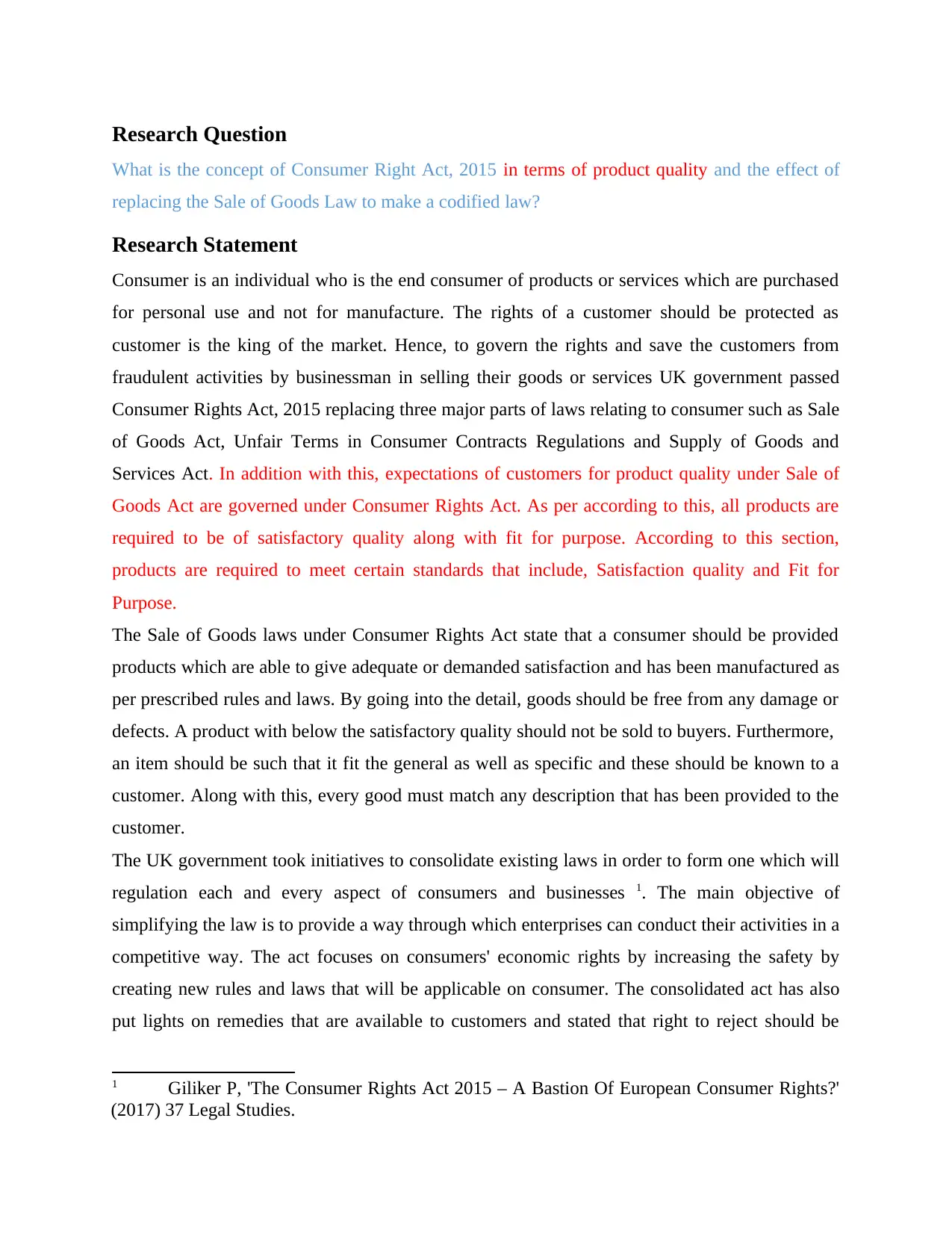
Research Question
What is the concept of Consumer Right Act, 2015 in terms of product quality and the effect of
replacing the Sale of Goods Law to make a codified law?
Research Statement
Consumer is an individual who is the end consumer of products or services which are purchased
for personal use and not for manufacture. The rights of a customer should be protected as
customer is the king of the market. Hence, to govern the rights and save the customers from
fraudulent activities by businessman in selling their goods or services UK government passed
Consumer Rights Act, 2015 replacing three major parts of laws relating to consumer such as Sale
of Goods Act, Unfair Terms in Consumer Contracts Regulations and Supply of Goods and
Services Act. In addition with this, expectations of customers for product quality under Sale of
Goods Act are governed under Consumer Rights Act. As per according to this, all products are
required to be of satisfactory quality along with fit for purpose. According to this section,
products are required to meet certain standards that include, Satisfaction quality and Fit for
Purpose.
The Sale of Goods laws under Consumer Rights Act state that a consumer should be provided
products which are able to give adequate or demanded satisfaction and has been manufactured as
per prescribed rules and laws. By going into the detail, goods should be free from any damage or
defects. A product with below the satisfactory quality should not be sold to buyers. Furthermore,
an item should be such that it fit the general as well as specific and these should be known to a
customer. Along with this, every good must match any description that has been provided to the
customer.
The UK government took initiatives to consolidate existing laws in order to form one which will
regulation each and every aspect of consumers and businesses 1. The main objective of
simplifying the law is to provide a way through which enterprises can conduct their activities in a
competitive way. The act focuses on consumers' economic rights by increasing the safety by
creating new rules and laws that will be applicable on consumer. The consolidated act has also
put lights on remedies that are available to customers and stated that right to reject should be
1 Giliker P, 'The Consumer Rights Act 2015 – A Bastion Of European Consumer Rights?'
(2017) 37 Legal Studies.
What is the concept of Consumer Right Act, 2015 in terms of product quality and the effect of
replacing the Sale of Goods Law to make a codified law?
Research Statement
Consumer is an individual who is the end consumer of products or services which are purchased
for personal use and not for manufacture. The rights of a customer should be protected as
customer is the king of the market. Hence, to govern the rights and save the customers from
fraudulent activities by businessman in selling their goods or services UK government passed
Consumer Rights Act, 2015 replacing three major parts of laws relating to consumer such as Sale
of Goods Act, Unfair Terms in Consumer Contracts Regulations and Supply of Goods and
Services Act. In addition with this, expectations of customers for product quality under Sale of
Goods Act are governed under Consumer Rights Act. As per according to this, all products are
required to be of satisfactory quality along with fit for purpose. According to this section,
products are required to meet certain standards that include, Satisfaction quality and Fit for
Purpose.
The Sale of Goods laws under Consumer Rights Act state that a consumer should be provided
products which are able to give adequate or demanded satisfaction and has been manufactured as
per prescribed rules and laws. By going into the detail, goods should be free from any damage or
defects. A product with below the satisfactory quality should not be sold to buyers. Furthermore,
an item should be such that it fit the general as well as specific and these should be known to a
customer. Along with this, every good must match any description that has been provided to the
customer.
The UK government took initiatives to consolidate existing laws in order to form one which will
regulation each and every aspect of consumers and businesses 1. The main objective of
simplifying the law is to provide a way through which enterprises can conduct their activities in a
competitive way. The act focuses on consumers' economic rights by increasing the safety by
creating new rules and laws that will be applicable on consumer. The consolidated act has also
put lights on remedies that are available to customers and stated that right to reject should be
1 Giliker P, 'The Consumer Rights Act 2015 – A Bastion Of European Consumer Rights?'
(2017) 37 Legal Studies.
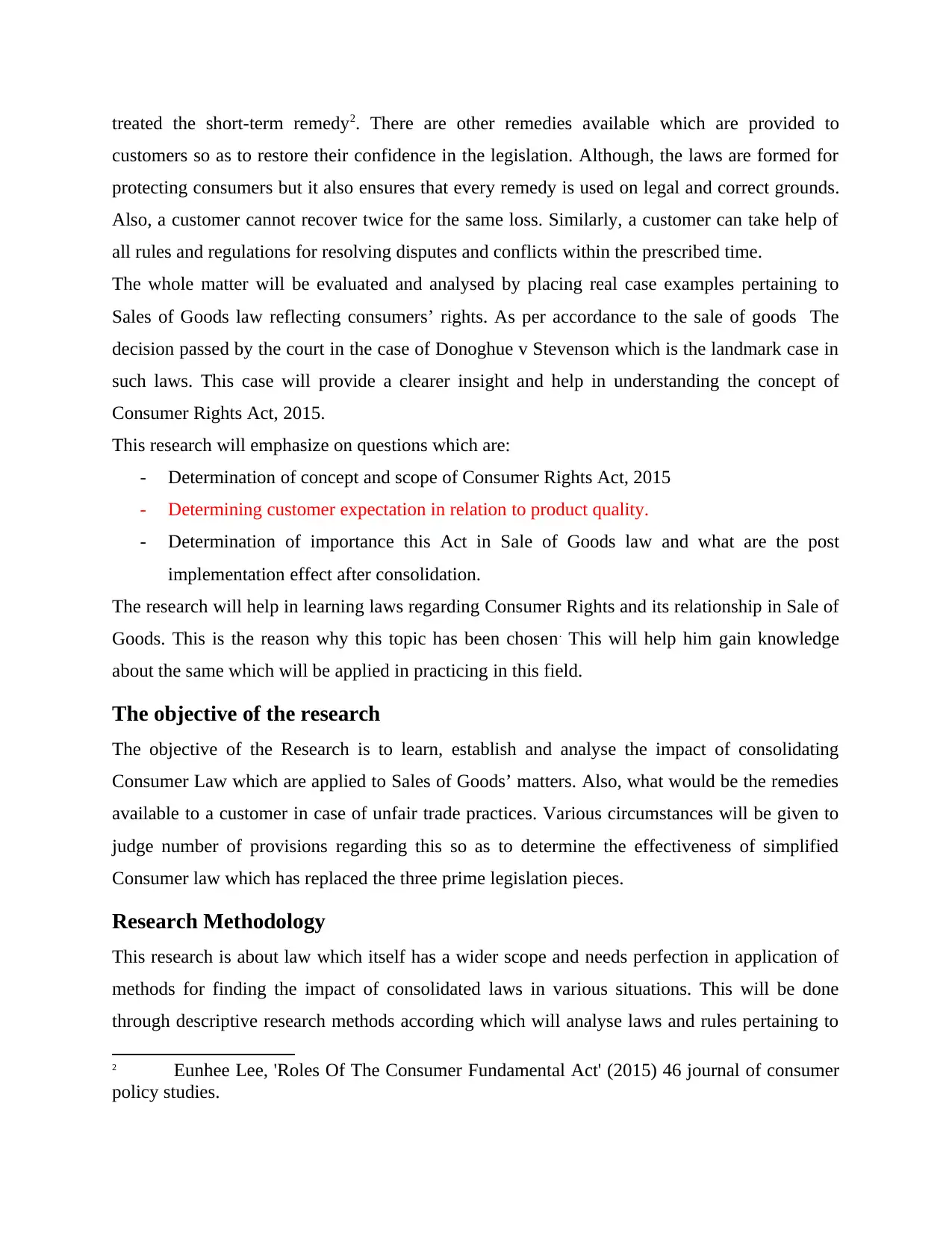
treated the short-term remedy2. There are other remedies available which are provided to
customers so as to restore their confidence in the legislation. Although, the laws are formed for
protecting consumers but it also ensures that every remedy is used on legal and correct grounds.
Also, a customer cannot recover twice for the same loss. Similarly, a customer can take help of
all rules and regulations for resolving disputes and conflicts within the prescribed time.
The whole matter will be evaluated and analysed by placing real case examples pertaining to
Sales of Goods law reflecting consumers’ rights. As per accordance to the sale of goods The
decision passed by the court in the case of Donoghue v Stevenson which is the landmark case in
such laws. This case will provide a clearer insight and help in understanding the concept of
Consumer Rights Act, 2015.
This research will emphasize on questions which are:
- Determination of concept and scope of Consumer Rights Act, 2015
- Determining customer expectation in relation to product quality.
- Determination of importance this Act in Sale of Goods law and what are the post
implementation effect after consolidation.
The research will help in learning laws regarding Consumer Rights and its relationship in Sale of
Goods. This is the reason why this topic has been chosen. This will help him gain knowledge
about the same which will be applied in practicing in this field.
The objective of the research
The objective of the Research is to learn, establish and analyse the impact of consolidating
Consumer Law which are applied to Sales of Goods’ matters. Also, what would be the remedies
available to a customer in case of unfair trade practices. Various circumstances will be given to
judge number of provisions regarding this so as to determine the effectiveness of simplified
Consumer law which has replaced the three prime legislation pieces.
Research Methodology
This research is about law which itself has a wider scope and needs perfection in application of
methods for finding the impact of consolidated laws in various situations. This will be done
through descriptive research methods according which will analyse laws and rules pertaining to
2 Eunhee Lee, 'Roles Of The Consumer Fundamental Act' (2015) 46 journal of consumer
policy studies.
customers so as to restore their confidence in the legislation. Although, the laws are formed for
protecting consumers but it also ensures that every remedy is used on legal and correct grounds.
Also, a customer cannot recover twice for the same loss. Similarly, a customer can take help of
all rules and regulations for resolving disputes and conflicts within the prescribed time.
The whole matter will be evaluated and analysed by placing real case examples pertaining to
Sales of Goods law reflecting consumers’ rights. As per accordance to the sale of goods The
decision passed by the court in the case of Donoghue v Stevenson which is the landmark case in
such laws. This case will provide a clearer insight and help in understanding the concept of
Consumer Rights Act, 2015.
This research will emphasize on questions which are:
- Determination of concept and scope of Consumer Rights Act, 2015
- Determining customer expectation in relation to product quality.
- Determination of importance this Act in Sale of Goods law and what are the post
implementation effect after consolidation.
The research will help in learning laws regarding Consumer Rights and its relationship in Sale of
Goods. This is the reason why this topic has been chosen. This will help him gain knowledge
about the same which will be applied in practicing in this field.
The objective of the research
The objective of the Research is to learn, establish and analyse the impact of consolidating
Consumer Law which are applied to Sales of Goods’ matters. Also, what would be the remedies
available to a customer in case of unfair trade practices. Various circumstances will be given to
judge number of provisions regarding this so as to determine the effectiveness of simplified
Consumer law which has replaced the three prime legislation pieces.
Research Methodology
This research is about law which itself has a wider scope and needs perfection in application of
methods for finding the impact of consolidated laws in various situations. This will be done
through descriptive research methods according which will analyse laws and rules pertaining to
2 Eunhee Lee, 'Roles Of The Consumer Fundamental Act' (2015) 46 journal of consumer
policy studies.
⊘ This is a preview!⊘
Do you want full access?
Subscribe today to unlock all pages.

Trusted by 1+ million students worldwide
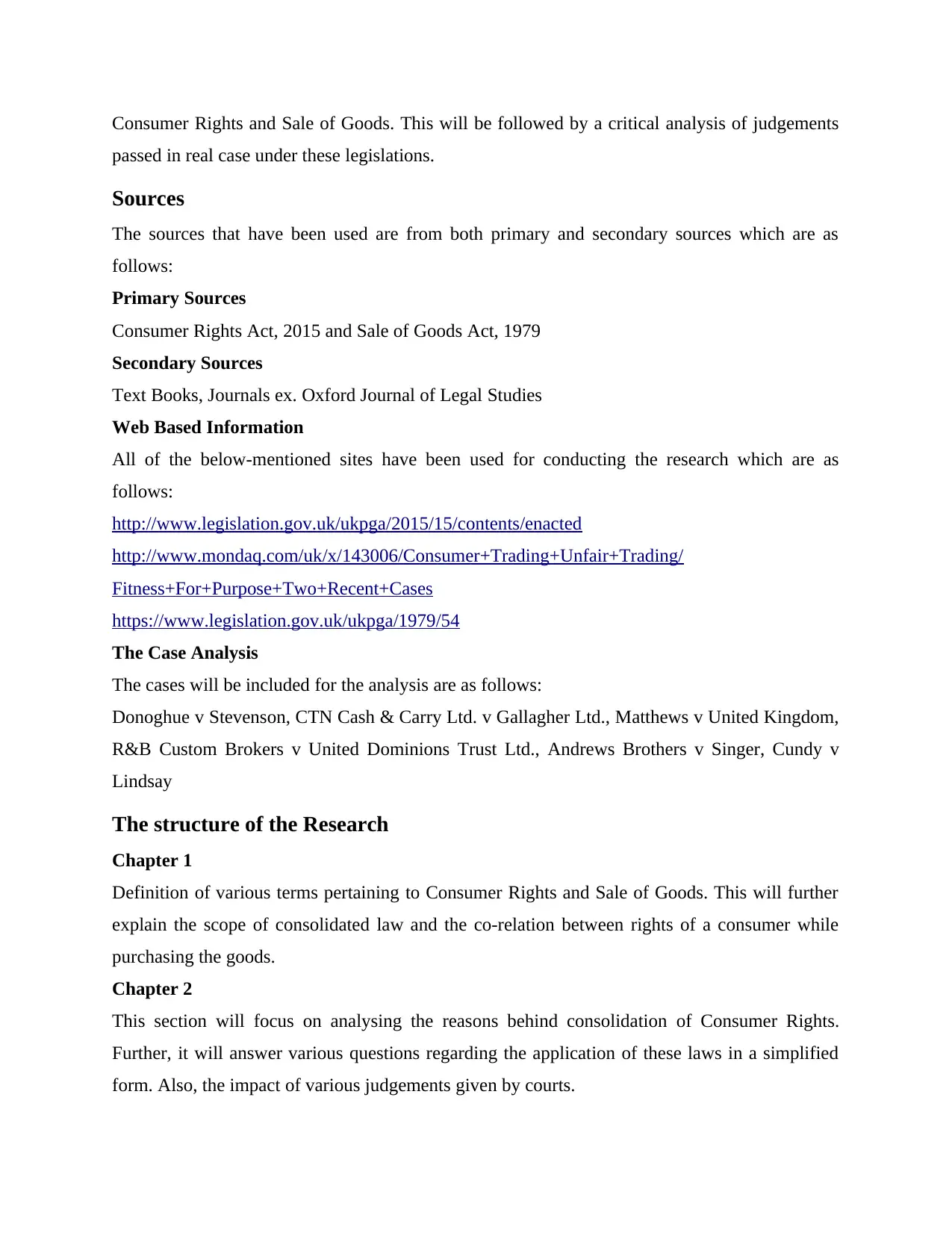
Consumer Rights and Sale of Goods. This will be followed by a critical analysis of judgements
passed in real case under these legislations.
Sources
The sources that have been used are from both primary and secondary sources which are as
follows:
Primary Sources
Consumer Rights Act, 2015 and Sale of Goods Act, 1979
Secondary Sources
Text Books, Journals ex. Oxford Journal of Legal Studies
Web Based Information
All of the below-mentioned sites have been used for conducting the research which are as
follows:
http://www.legislation.gov.uk/ukpga/2015/15/contents/enacted
http://www.mondaq.com/uk/x/143006/Consumer+Trading+Unfair+Trading/
Fitness+For+Purpose+Two+Recent+Cases
https://www.legislation.gov.uk/ukpga/1979/54
The Case Analysis
The cases will be included for the analysis are as follows:
Donoghue v Stevenson, CTN Cash & Carry Ltd. v Gallagher Ltd., Matthews v United Kingdom,
R&B Custom Brokers v United Dominions Trust Ltd., Andrews Brothers v Singer, Cundy v
Lindsay
The structure of the Research
Chapter 1
Definition of various terms pertaining to Consumer Rights and Sale of Goods. This will further
explain the scope of consolidated law and the co-relation between rights of a consumer while
purchasing the goods.
Chapter 2
This section will focus on analysing the reasons behind consolidation of Consumer Rights.
Further, it will answer various questions regarding the application of these laws in a simplified
form. Also, the impact of various judgements given by courts.
passed in real case under these legislations.
Sources
The sources that have been used are from both primary and secondary sources which are as
follows:
Primary Sources
Consumer Rights Act, 2015 and Sale of Goods Act, 1979
Secondary Sources
Text Books, Journals ex. Oxford Journal of Legal Studies
Web Based Information
All of the below-mentioned sites have been used for conducting the research which are as
follows:
http://www.legislation.gov.uk/ukpga/2015/15/contents/enacted
http://www.mondaq.com/uk/x/143006/Consumer+Trading+Unfair+Trading/
Fitness+For+Purpose+Two+Recent+Cases
https://www.legislation.gov.uk/ukpga/1979/54
The Case Analysis
The cases will be included for the analysis are as follows:
Donoghue v Stevenson, CTN Cash & Carry Ltd. v Gallagher Ltd., Matthews v United Kingdom,
R&B Custom Brokers v United Dominions Trust Ltd., Andrews Brothers v Singer, Cundy v
Lindsay
The structure of the Research
Chapter 1
Definition of various terms pertaining to Consumer Rights and Sale of Goods. This will further
explain the scope of consolidated law and the co-relation between rights of a consumer while
purchasing the goods.
Chapter 2
This section will focus on analysing the reasons behind consolidation of Consumer Rights.
Further, it will answer various questions regarding the application of these laws in a simplified
form. Also, the impact of various judgements given by courts.
Paraphrase This Document
Need a fresh take? Get an instant paraphrase of this document with our AI Paraphraser
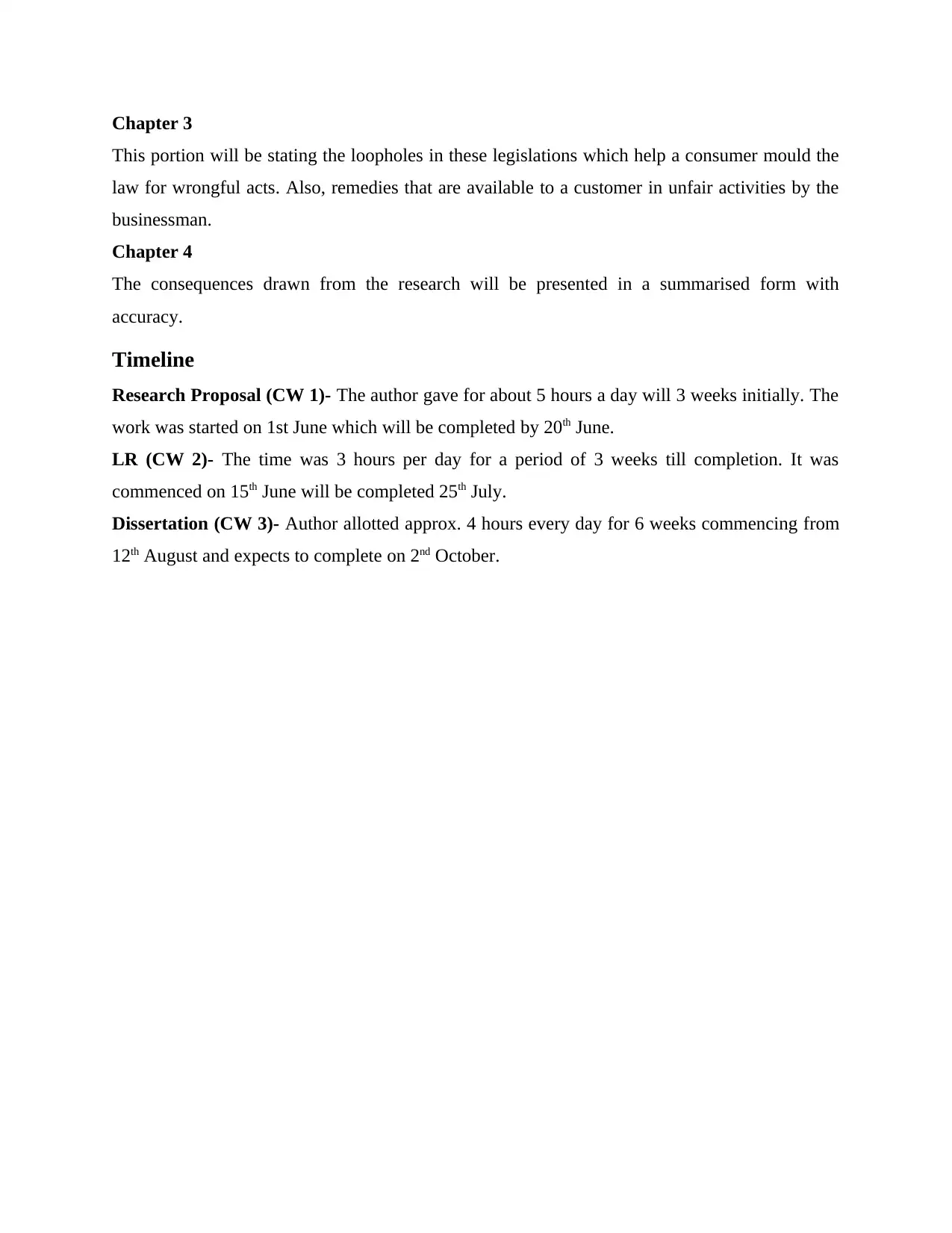
Chapter 3
This portion will be stating the loopholes in these legislations which help a consumer mould the
law for wrongful acts. Also, remedies that are available to a customer in unfair activities by the
businessman.
Chapter 4
The consequences drawn from the research will be presented in a summarised form with
accuracy.
Timeline
Research Proposal (CW 1)- The author gave for about 5 hours a day will 3 weeks initially. The
work was started on 1st June which will be completed by 20th June.
LR (CW 2)- The time was 3 hours per day for a period of 3 weeks till completion. It was
commenced on 15th June will be completed 25th July.
Dissertation (CW 3)- Author allotted approx. 4 hours every day for 6 weeks commencing from
12th August and expects to complete on 2nd October.
This portion will be stating the loopholes in these legislations which help a consumer mould the
law for wrongful acts. Also, remedies that are available to a customer in unfair activities by the
businessman.
Chapter 4
The consequences drawn from the research will be presented in a summarised form with
accuracy.
Timeline
Research Proposal (CW 1)- The author gave for about 5 hours a day will 3 weeks initially. The
work was started on 1st June which will be completed by 20th June.
LR (CW 2)- The time was 3 hours per day for a period of 3 weeks till completion. It was
commenced on 15th June will be completed 25th July.
Dissertation (CW 3)- Author allotted approx. 4 hours every day for 6 weeks commencing from
12th August and expects to complete on 2nd October.
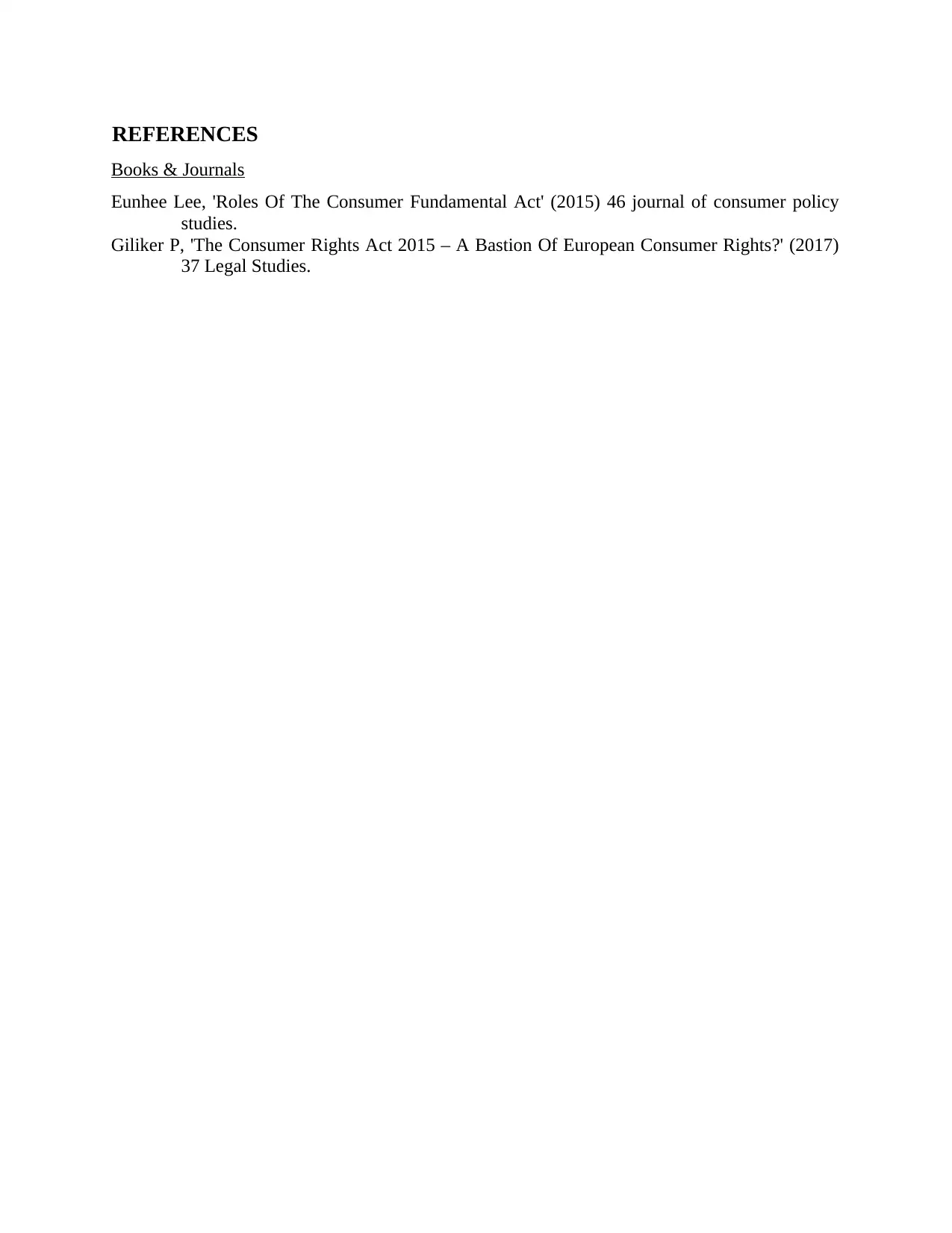
REFERENCES
Books & Journals
Eunhee Lee, 'Roles Of The Consumer Fundamental Act' (2015) 46 journal of consumer policy
studies.
Giliker P, 'The Consumer Rights Act 2015 – A Bastion Of European Consumer Rights?' (2017)
37 Legal Studies.
Books & Journals
Eunhee Lee, 'Roles Of The Consumer Fundamental Act' (2015) 46 journal of consumer policy
studies.
Giliker P, 'The Consumer Rights Act 2015 – A Bastion Of European Consumer Rights?' (2017)
37 Legal Studies.
⊘ This is a preview!⊘
Do you want full access?
Subscribe today to unlock all pages.

Trusted by 1+ million students worldwide
1 out of 6
Related Documents
Your All-in-One AI-Powered Toolkit for Academic Success.
+13062052269
info@desklib.com
Available 24*7 on WhatsApp / Email
![[object Object]](/_next/static/media/star-bottom.7253800d.svg)
Unlock your academic potential
Copyright © 2020–2025 A2Z Services. All Rights Reserved. Developed and managed by ZUCOL.



